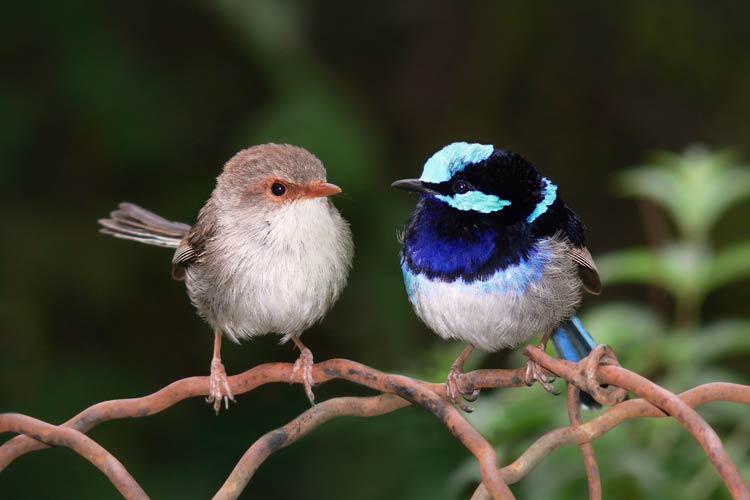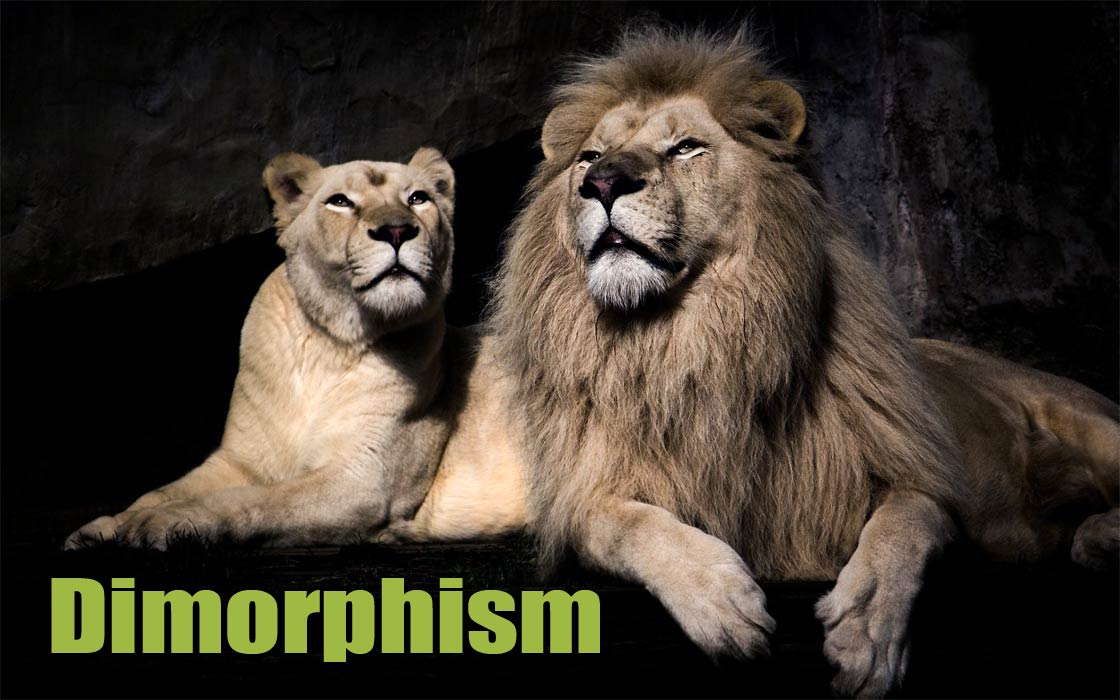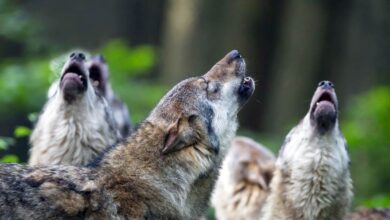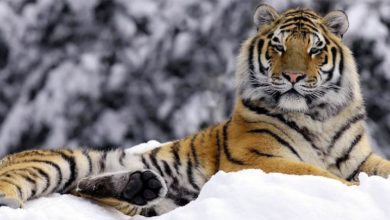Understanding dimorphism – why are males and females so different?
Sexual dimorphism is a phenomenon in which males and females of the same species differ from each other not only in the structure of their reproductive organs, but also in appearance, behavior, or physiology. These differences are shaped by evolution – survival pressure, competition for mates, and reproductive strategies. In the natural world, this can mean both the spectacular feathers of a male peacock and the much larger size of a female in some spiders.
Sexual dimorphism provides valuable information about the mechanisms of natural and sexual selection, as well as the strategies that allow species to survive. Today, we will present striking examples of dimorphism in various species and show its significance in humans.
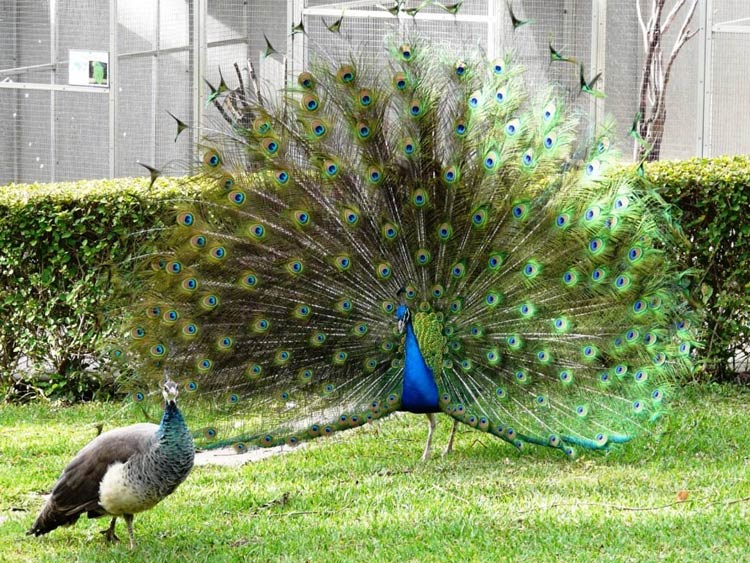
What is sexual dimorphism?
Sexual dimorphism refers to the differences between males and females within a single species, encompassing both physical traits – such as body size, coloration, or the presence of additional structures, e.g., horns – and behaviors, such as courtship rituals or the division of parental care. The main mechanism shaping these differences is evolution, specifically two of its processes: natural selection and sexual selection. Natural selection favors traits that increase survival chances, e.g., protective coloration in females, while sexual selection reinforces traits attractive to potential mates, like spectacular feathers in males or their physical strength or beauty.
Sexual dimorphism results from an evolutionary compromise – traits beneficial to one sex are not necessarily advantageous for the other. For example, in many species, males invest energy in competing for females, while females focus on caring for offspring. These differences are encoded in genes and often controlled by sex chromosomes and hormones, such as testosterone and estrogen. However, biology is not the only factor – environmental and social factors can also influence the degree of dimorphism in a given species.
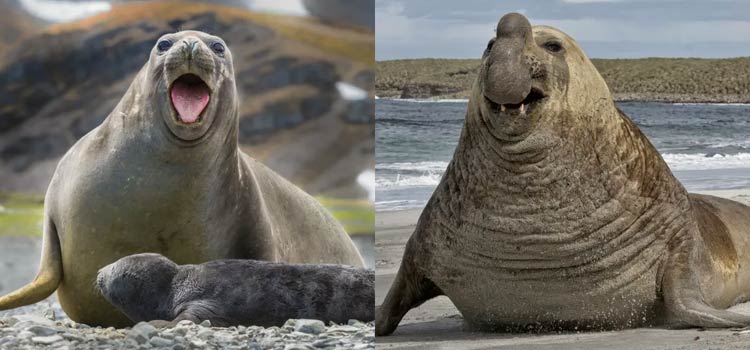
Mechanisms of sexual dimorphism
Sexual dimorphism has its roots in genetics and evolution. In species where sex is determined by chromosomes – like XX in females and XY in male mammals – differences begin at the gene level. These genes control the production of hormones, which in turn influence the development of sexual characteristics. Testosterone promotes muscle growth and antler development in deer (Cervidae), while estrogen regulates the reproductive cycle and fat tissue distribution in females. Over millions of years of evolution, these mechanisms have been shaped by the pressure of natural and sexual selection, leading to distinct differences between males and females. From generation to generation, mutations beneficial to one sex become fixed, gradually deepening these differences.
Sexual dimorphism is shaped by two main evolutionary mechanisms:
- Natural selection – traits that increase the chances of survival become fixed in the population. An example is the camouflage coloration of female ground-nesting birds, which helps them avoid predators – e.g., in blackbirds (Turdus merula), the female has camouflage coloration, while the male is black.
- Sexual selection – traits that increase attractiveness to a partner or dominance over rivals are enhanced. It is thanks to this that male Indian peafowl (Pavo cristatus) have impressive, colorful tails, and lions (Panthera leo) develop thick manes, indicating their strength and health.
Additionally, environmental pressure – e.g., the presence of predators or food availability – can modify these traits, making them more adapted to specific living conditions. In humans, sexual dimorphism is also influenced by culture, which can reinforce or weaken biological differences. Social norms, the division of roles, and behavioral patterns shape how we perceive masculinity and femininity. Today, in many Western societies, gender equality means that some traditional differences are becoming blurred – although the biological foundations remain unchanged.
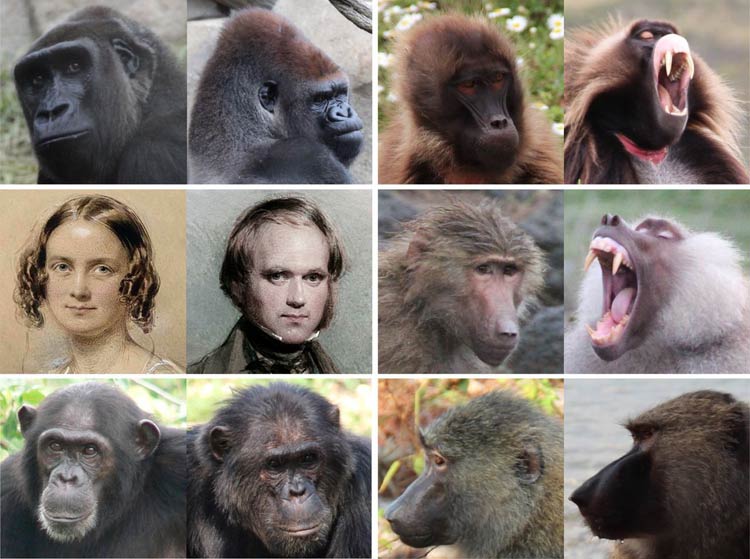
Examples of sexual dimorphism in nature
Sexual dimorphism takes on surprisingly diverse forms – from subtle differences in coloration to extreme contrasts in body structure and behavior. In the animal world, one can find both males dazzling with colorful appearances and females who have reached gigantic sizes compared to their partners. Here are a few examples that best illustrate this phenomenon.
Indian peafowl (Pavo cristatus)
- What distinguishes them?
Males sport spectacular fan-shaped tails with iridescent colors, while females have more modest, brown plumage. - Why does this happen?
The male’s colorful tail is a classic example of sexual selection – it is a costly signal of his fitness. Only the healthiest individuals can afford such extravagance, as maintaining such a tail requires energy and makes them more visible to predators. This is sexual selection at its most spectacular. Females, who focus on raising offspring, benefit from more subdued coloration that allows them to better hide in their environment.

Anglerfish (Lophiiformes)
- What distinguishes them?
Females of these deep-sea fish are significantly larger and equipped with a bioluminescent lure, while males are tiny and play a parasitic role in the female’s life. - Why does this happen?
In the dark, deep-sea waters, where finding a mate is a challenge, male anglerfish attach themselves to females, fusing with their bodies. Over time, they become almost exclusively sperm donors, and their size and functions are limited to reproduction. Females, on the other hand, as larger individuals, use a bioluminescent lure to catch food, which allows them to survive in the demanding ocean conditions.
African lion (Panthera leo)
- What distinguishes them?
Male lions are distinguished by their impressive, thick manes, while females lack them. - Why does this happen?
The male’s mane serves as a signal of dominance and provides protection during fights with other males. It is also a sign of strength, which is attractive in the context of sexual selection. Females, as the primary hunters in the pride, do not need such protection. Their slender build and lack of a mane allow them greater agility during hunts, which increases their effectiveness.
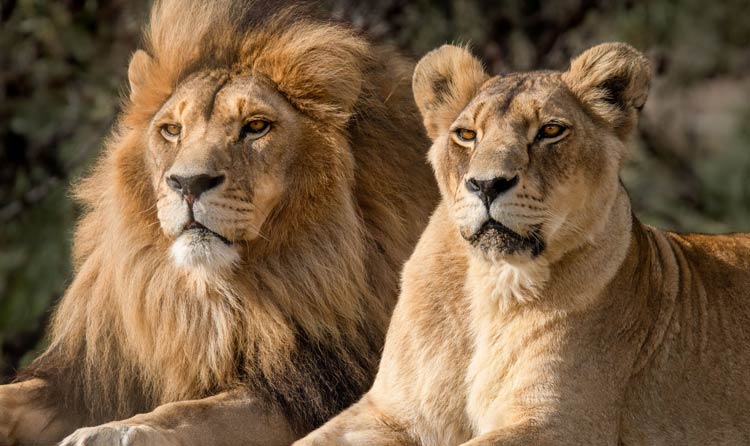
Black widow spiders (Latrodectus)
- What distinguishes them?
Female black widows are significantly larger, with a glossy, black coloration, while males are small and dull. - Why does this happen?
The female’s size is crucial for her egg-production capacity. Additionally, female black widows are known for a controversial strategy – after copulation, they often eat the male, which is a form of drastic resource securing. Males, despite this risk, prioritize reproduction, disregarding their longevity – similarly to some snake species. This reproductive method illustrates the extreme costs of sexual dimorphism, where differences between the sexes are clearly marked at the biological level.

Mandarin duck (Aix galericulata)
- What distinguishes them?
Male mandarin ducks are distinguished by their vibrant, multicolored feathers, while females have more subdued, gray-brown coloration. - Why does this happen?
The male’s coloration is intended to attract females during the breeding season. His colorful plumage is a striking signal aimed at attracting females and showing her health and fitness. After the mating season, females, having more subdued colors, can more easily hide from predators, especially while incubating eggs.

Elephant seal (Mirounga)
- What distinguishes them?
Male elephant seals are significantly larger than females, and their bodies are more massive, with a characteristic large, inflated “nose,” or proboscis, which is used to produce loud sounds and attract females. - Why does this happen?
The large size of males is a result of intense competition among them for territories and females. Males fight for dominance within the herd, and their proboscis serves as a signal of their strength and fighting abilities. In females, on the other hand, the priority is producing offspring, so their bodies have remained smaller and more agile, which is beneficial in the context of their role in caring for the young.
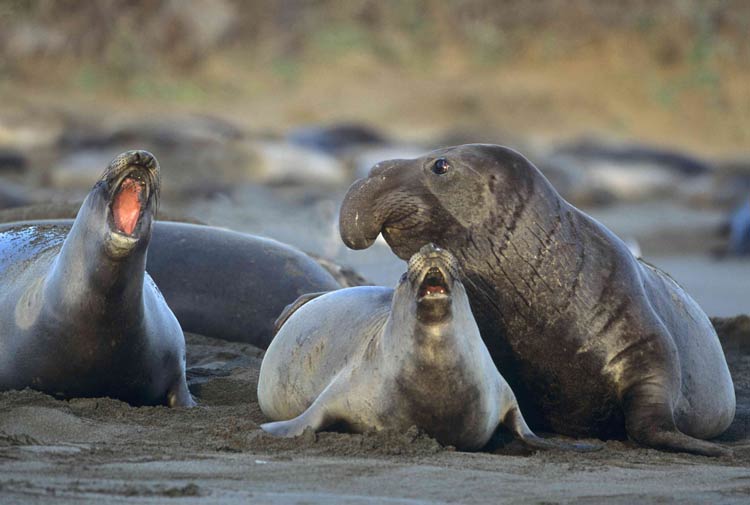
Mandrill (Mandrillus sphinx)
- What distinguishes them?
Male mandrills are significantly larger than females and have intensely colored, expressive faces. Females are smaller and less colorful. - Why does this happen?
The colorful features of males, including the intense shades of red and blue on their faces, are signals of attractiveness and dominance, aimed at attracting females. These colorful markings are a result of sexual selection, as males with more vivid colors are often perceived as stronger and healthier, and therefore more desirable to females. Female mandrills, not actively participating in competition for mates, do not need to exhibit the same color expression.
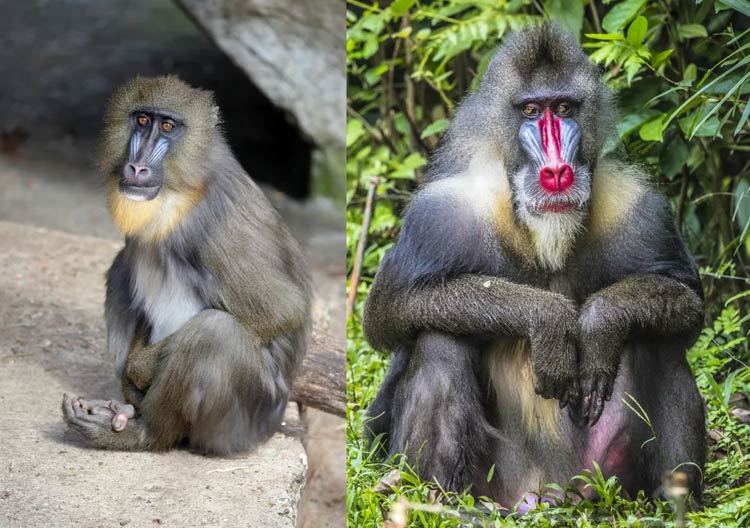
Sexual dimorphism in humans
In humans, sexual dimorphism is more subtle than in many other species, such as the Indian peafowl or anglerfish, but still noticeable. Men typically have greater muscle mass, broader shoulders, and more pronounced facial hair, which is a result of higher testosterone levels. Women, on the other hand, have wider hips, more body fat, and developed breasts, which are associated with the effects of estrogen and reproductive needs, such as pregnancy and childcare. These physical differences reflect traditional gender roles – hunting and competition in men, and pregnancy and raising young in women.
When it comes to behavioral differences, they are less clear-cut and often a subject of debate. Studies suggest that men may be more prone to risk-taking and have better spatial orientation skills, while women more often exhibit higher levels of verbal fluency and empathy. Culture has a huge impact on these tendencies, reinforcing some traits associated with dimorphism – for example, physical culture in men (bodybuilding) or social pressure on appearance in women, symbolized by cosmetics and beauty care.
Contemporary social, environmental, and technological changes are making sexual dimorphism less pronounced. Improved access to healthcare, better diet, and changing social roles mean that physical and behavioral differences between the sexes are no longer as rigidly defined as they were in the past. Nevertheless, our biology still carries traces of our evolutionary past.

Evolutionary significance of dimorphism
Sexual dimorphism is not accidental – it serves as a tool for evolutionary survival. In species where males compete for access to females, such as in elephant seals (Mirounga), traits that emphasize their dominance develop, such as impressive body size or powerful tusks. In species where females invest a significant amount of energy in offspring (e.g., birds), males take on the role of being “showy” – attracting the attention of the female – through bright coloration or impressive displays. This differentiation of gender roles maximizes the reproductive success of the species, while balancing competition and cooperation between individuals.
It is worth adding, however, that sexual dimorphism is not static. In some groups, such as in certain birds of the genus Phalaropus, females are more colorful and compete for males, who in turn take on the responsibility of incubating eggs. This reversal of traditional roles shows how dimorphism can adapt to changing environmental and ecological conditions. Evolution, thanks to its flexibility, responds to what best promotes the survival of a given species.
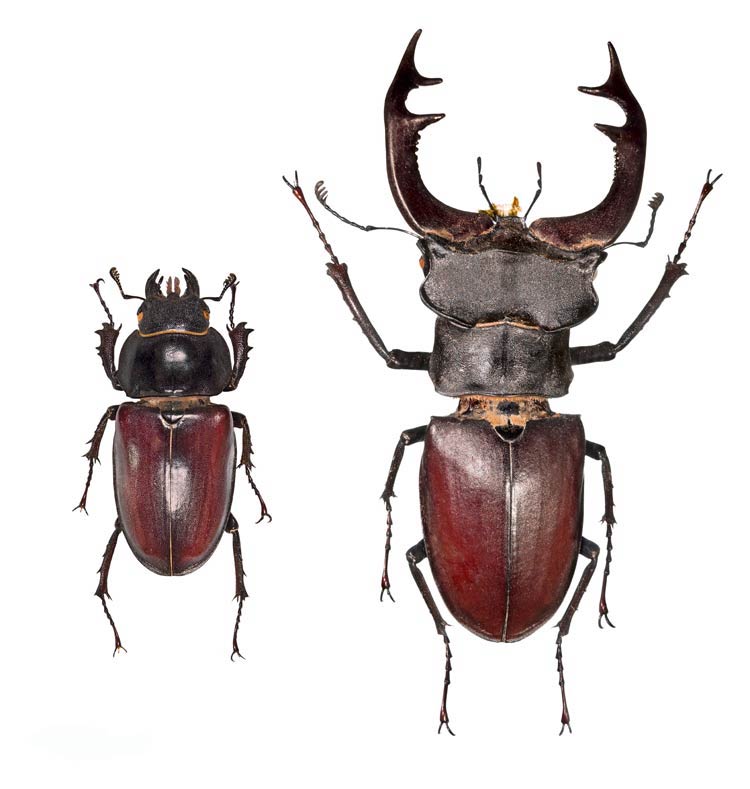
Sexual dimorphism – interesting facts
- Size reversal: In many species of birds of prey, such as hawks (Accipitridae), females are larger than males. This type of sexual dimorphism is likely related to the need to defend nests from predators or manage larger prey, which is beneficial for breeding success.
- Color change: Male cuttlefish (Sepia officinalis) often adopt coloration resembling females to cleverly sneak past rival males. This type of camouflage is a perfect example of how dimorphism can be used to avoid competition.
- Height in humans: On a global scale, men on average reach 5-10% greater height than women, but this difference is decreasing in populations with good nutritional conditions, which highlights the influence of the environment on the development of sexual dimorphism.
- Extinct giants: Male woolly mammoths (Mammuthus primigenius) had larger and more curved tusks than females, which was probably related to competition for dominance or using them in fights, which was a way to attract a partner.
- Songbirds: In many species of songbirds, such as the golden oriole (Oriolus oriolus), only males sing. Their complex melodies are used to defend territory and attract females, providing a clear example of dimorphism in a behavioral context.
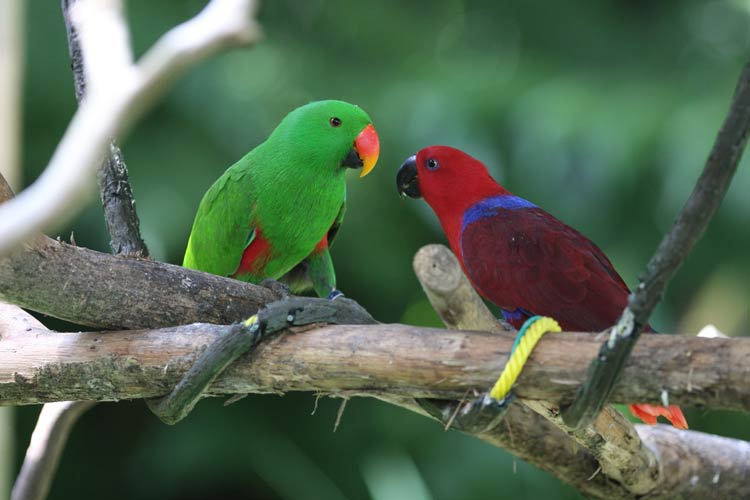
Summary
Sexual dimorphism is one of the most fascinating phenomena in biology, demonstrating how various evolutionary forces shape the physical, behavioral, and physiological traits of males and females within the same species. From differences in size, through variations in coloration, to the diversification of roles in mating behaviors, dimorphism plays a crucial role in the reproductive success and survival of many species. Forces such as natural and sexual selection drive these changes, and these differences often reflect a complex compromise between survival and reproduction.
In nature, sexual dimorphism is present in such diverse forms that it becomes one of the most intriguing examples of evolutionary adaptations. For some species, like the Indian peafowl (Pavo cristatus) or the African lion (Panthera leo), the differences between males and females are pronounced and easily noticeable. In other cases, such as in some anglerfish species (Lophiiformes) or black widow spiders (Latrodectus), dimorphism takes on less obvious forms, related to survival and reproductive strategies.
In humans, although sexual differences are less pronounced, they still remain a significant element of our biology and culture. Contemporary societies, where the pursuit of gender equality has blurred many differences between the sexes, show how flexible sexual dimorphism is in response to changing environmental and cultural conditions. However, the connection between our evolutionary traits and the social roles that shape our behavior and appearance is still visible.
The evolution of sexual dimorphism is a dynamic process that constantly adapts to new challenges posed by the environment, as well as to the internal needs of species. Understanding it helps us better understand not only nature but also the evolutionary context in which our contemporary traits arose.
